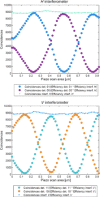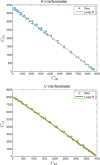Experimental verification of an indefinite causal order
- PMID: 28378018
- PMCID: PMC5365250
- DOI: 10.1126/sciadv.1602589
Experimental verification of an indefinite causal order
Abstract
Investigating the role of causal order in quantum mechanics has recently revealed that the causal relations of events may not be a priori well defined in quantum theory. Although this has triggered a growing interest on the theoretical side, creating processes without a causal order is an experimental task. We report the first decisive demonstration of a process with an indefinite causal order. To do this, we quantify how incompatible our setup is with a definite causal order by measuring a "causal witness." This mathematical object incorporates a series of measurements that are designed to yield a certain outcome only if the process under examination is not consistent with any well-defined causal order. In our experiment, we perform a measurement in a superposition of causal orders-without destroying the coherence-to acquire information both inside and outside of a "causally nonordered process." Using this information, we experimentally determine a causal witness, demonstrating by almost 7 SDs that the experimentally implemented process does not have a definite causal order.
Keywords: Quantum Foundations; Quantum Information; Quantum Optics.
Figures








References
-
- Chiribella G., D’Ariano G. M., Perinotti P., Valiron B., Quantum computations without definite causal structure. Phys. Rev. A 88, 022318 (2013).
-
- Brukner Č., Quantum causality. Nat. Phys. 10, 259–263 (2014).
-
- L. Hardy, Quantum Gravity Computers: On the Theory of Computation with Indefinite Causal Structure (Springer Netherlands, 2009), pp. 379–401.
-
- Chiribella G., Perfect discrimination of no-signalling channels via quantum superposition of causal structures. Phys. Rev. A 86, 040301(R) (2012).
LinkOut - more resources
Full Text Sources
Other Literature Sources

